
Apocynaceae is a family of flowering plants that includes trees, shrubs, herbs, stem succulents, and vines, commonly known as the dogbane family, because some taxa were used as dog poison. Members of the family are native to the European, Asian, African, Australian, and American tropics or subtropics, with some temperate members. The former family Asclepiadaceae is considered a subfamily of Apocynaceae and contains 348 genera. A list of Apocynaceae genera may be found here.

Pachypodium is a genus of succulent spine-bearing trees and shrubs, native to Madagascar and Africa. It belongs to the family Apocynaceae.

Nerium oleander, most commonly known as oleander or nerium, is a shrub or small tree belonging to subfamily Apocynoideae of the dogbane family Apocynaceae and is cultivated worldwide in temperate and subtropical areas as an ornamental and landscaping plant. It is the only species currently classified in the genus Nerium. It is so widely cultivated that no precise region of origin has been identified, though it is usually associated with the Mediterranean Basin.
A storage organ is a part of a plant specifically modified for storage of energy (generally in the form of carbohydrates) or water. Storage organs often grow underground, where they are better protected from attack by herbivores. Plants that have an underground storage organ are called geophytes in the Raunkiær plant life-form classification system. Storage organs often, but not always, act as perennating organs which enable plants to survive adverse conditions.
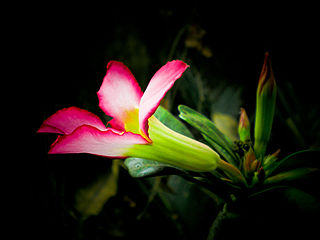
Adenium is a genus of flowering plants in the family Apocynaceae first described as a genus in 1819. It is native to Africa and the Arabian Peninsula.

Daphnis nerii, the oleander hawk-moth or army green moth, is a moth of the family Sphingidae. It was described by Carl Linnaeus in his 1758 10th edition of Systema Naturae.
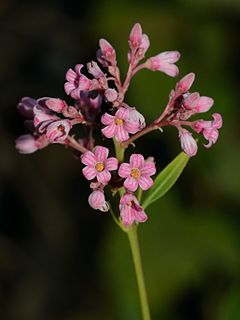
Apocynoideae is a subfamily of the flowering plant family Apocynaceae. It contains about 78 genera with roughly 860 species. Several genera are of pharmacological interest - notably those - such as Strophanthus - which have furnished highly effective arrow poisons, due to their cardiac glycoside content. The subfamily includes many species with flowers of considerable ornamental value, the best-known of which is Nerium oleander, the familiar Oleander. It also contains the remarkable pachycaul genera Adenium and Pachypodium.

Adenium obesum is a poisonous species of flowering plant belonging to tribe Nerieae of subfamily Apocynoideae of the dogbane family, Apocynaceae, that is native to the Sahel regions, south of the Sahara, and tropical and subtropical eastern and southern Africa and Arabia. Common names include Sabi star, kudu, mock azalea, impala lily and desert rose.
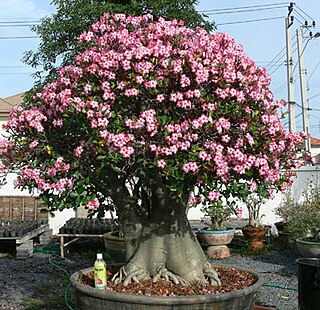
Adenium arabicum is a species of plant commonly used for bonsai and cultivated for its leaves, growth form and flowering characteristics.
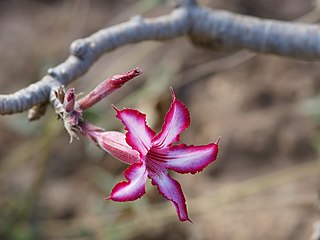
Adenium multiflorum is small, succulent tree native to central and eastern Southern Africa. Like other succulent members of the family Apocynaceae, A. multiflorum has a milky latex with toxic alkaloids, specifically Cardiac glycosides. This latex is used as an arrow poison and as a fish stunning poison.

Psydrax oleifolia, commonly known as wild lemon or brush myrtle, is a species of shrub or small tree in the family Rubiaceae. It is endemic to eastern and inland Australia,.

Cissus subaphylla is a low shrub in the grape family Vitaceae. It is endemic to the Yemeni island of Socotra. The plant grows mainly in dry, low-lying areas on alluvial fans or on limestone slopes, and is rarely found above elevations of 300 metres (980 ft), where it is replaced by C. hamaderohensis. It does not have the climbing habit of other Cissus species, and its stems are flattened and gray-green in colour, with relatively small leaves and flowers. The tangled mats of C. subaphylla stems act as a protective covering for plants regularly eaten by goats and other browsing animals; the plant is thus important in the rehabilitation of species such as Dendrosicyos, Maerua and Commiphora.

Alectryon oleifolius, commonly known as the boonaree or inland rosewood, is a species of small tree of the soapberry family Sapindaceae, native to Australia.
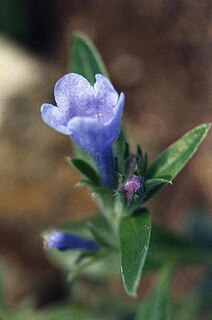
Glandora oleifolia, the olive-leaved gromwell, is a species of flowering plant in the family Boraginaceae. The plant is native to a small rocky area near Figueras in the eastern Pyrenees, and is endemic to Spain.

Adenium swazicum is a species of flowering plant in the family Apocynaceae, that is native to the lowveld of Eswatini and the Mpumalanga province of South Africa.
Spongiosperma is a genus of plant in family Apocynaceae first described as a genus in 1988. It is native to the South America, nations of Venezuela, Colombia, and Brazil.

The common beisa oryx, also known as the beisa oryx, is the nominate subspecies of the East African oryx native to the Horn of Africa and Kenya. It is closely related to the fringe-eared oryx. There are four species of oryx, one of which has two distinct subspecies. Although they are very similar in appearance, they have a number of distinct characteristics that allow identification. Common beisa oryx have fringed ears and black tufts of hair that extend past their ears. However, all species of oryx are compact and muscular, with relative long bodies and broad necks. There are not any marked difference between male and female oryx. The common beisa oryx enjoys feeding on a variety of grass species. They feed during the day, when the plants hold the most water. During the dry season, they feed on poisonous Adenium plants.

Leucospermum oleifolium is an erect shrub of about 1 m (3.3 ft) high and 1½ m (5 ft) across that is assigned to the family Proteaceae. It has spreading branches, densely set with initially felty, entire, oval, olive-colored leaves of about 3½ cm long and 1½ cm (0.6 in) wide, with a bony tip that sometimes has two to five blunt teeth, with a blunt base and conspicuous veins. The flowers and their long thread-like styles are initially sulfur yellow, but soon become orange and finally turn brilliant crimson. The flower heads are about 4 cm (1.6 in) in diameter, crowded at the tip of the branches with a maximum of five that start flowering in turn. This provides for a colour spectacle from August till December. It is called by various names in South Africa such as Overberg pincushion, flame pincushion, mix pincushion and tuft pincushion. It naturally occurs in fynbos in the Western Cape province of South Africa.

Leucospermum calligerum is a softly hairy shrub, with wand-like branches, entire ovate leaves that have a bony tip of about 25 × 6 mm, and globular heads of 2–3½ cm (0.8–1.4 in) in diameter, with two to six together near the tip of the branches and flowering in turn, that consist of 4-merous flowers, initially cream-colored, later pink, with the petals curled and the styles 2–2½ cm (0.8–1.0 in) long, sticking out like pins from a cushion. It is called arid pincushion or common louse pincushion in English and rooiluisie in Afrikaans. Well-scented flowers can be found from July to January. It naturally occurs in fynbos in the Northern Cape and Western Cape provinces of South Africa.

Gordon Douglas Rowley (1921–2019) was a British botanist and writer specialising in cacti and succulents.


















